Suillus Adans.
A number of species are known in Europe. Fruitbody boletoid without or with partial veil, and then leaving a ring on the stipe. Cap in most species more or less viscid. Stipe solid.
Suillus collinitus (Fr. : Fr.) Kuntze
Description
Cap up to 10 cm, at first hemispherical then expanding to convex, brown to dark brown, viscid when wet. Stipe, cylindrical, often tapering below, more or less yellowish, without ring, covered with numerous small whitish to brownish glandular dots; stipe base and the basal mycelium pinkish. Flesh whitish to yellowish, somewhat pinkish in the stipe base. Tubes pale yellow to olivaceous yellow. Pores fine, rounded, pale yellow to olivaceous yellow. Smell not distinctive. Taste not distinctive. Spores 8–10 × 3.5–4 μm.
Habitat. Coniferous or mixed forests, artificial plantations, mycorrhizal with pines (Pinus).
Distribution. In Europe widespread and probably often overlooked.
Similarity. Probably sometimes confused with Suillus granulatus, the later however has whitish stipe base and basal mycelium and usually paler cap.
Photographs
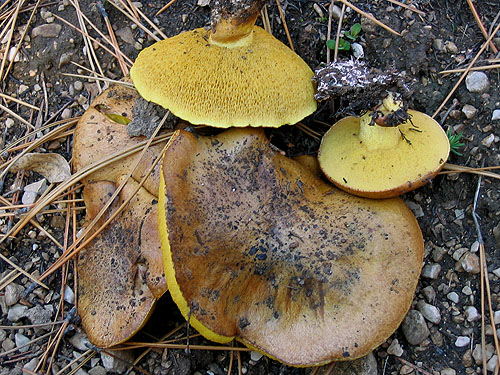
Typical fruitbodies of Suillus collinitus. (photo B. Assyov)
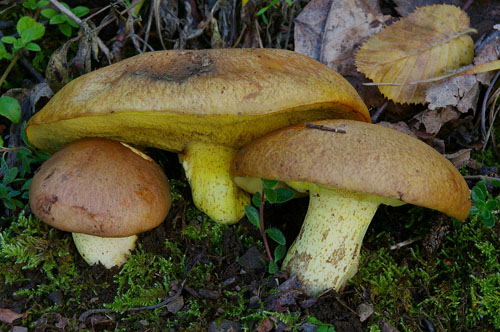
Fruitbodies of Suillus collinitus. (photo M. Mikšík)
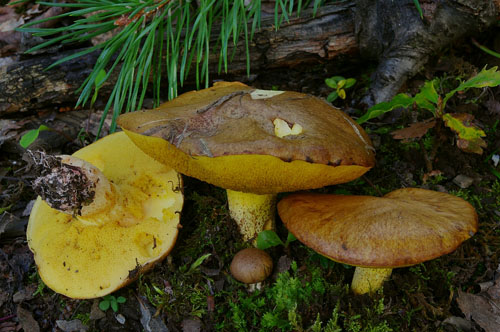
Fruitbodies of Suillus collinitus. On the fruitbody on the left note the pinkish tint in the stipe base. (photo M. Mikšík)
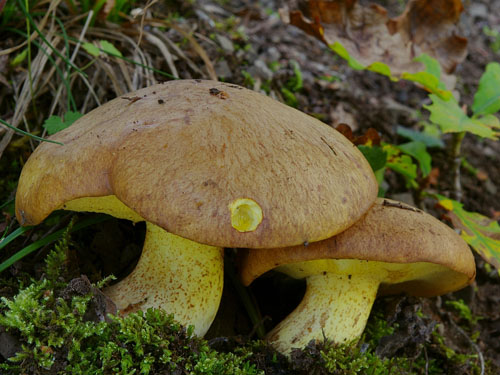
Fruitbodies of Suillus collinitus. Note the prominent granulation on the stipes. (photo M. Mikšík)
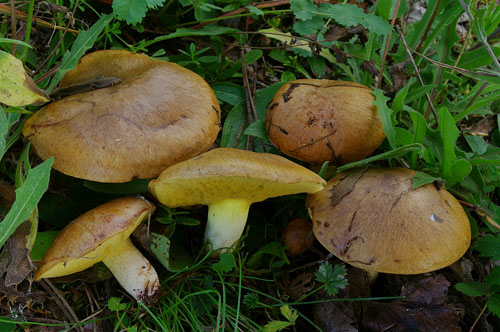
Rich collection of Suillus collinitus. (photo M. Mikšík)

Pinkish basal mycelium of Suillus collinitus. (photo B. Assyov)
Important literature
Alessio, C.L. 1985. Boletus Dill. ex L. (sensu lato). – In: Fungi Europaei. Vol. 2. Pp. 1–705. Libreria editrice Biella Giovanna, Saronno.
Engel, H., Dermek, A., Klofac, W., Ludwig, E. & Brückner, T. 1996. Schmier – und Filzröhrlinge s. l. in Europa. Die Gattungen Boletellus, Boletinus, Phylloporus, Suillus, Xerocomus. Verlag Heinz Engel, Weidhausen b. Coburg.
Estadès, A. & Lannoy, G. 2004. Les bolets européens. – Bulletin Mycologique et Botanique Dauphiné-Savoie 44(3): 3–79.
Galli, R. 1998. I Boleti. Atlante pratico-monographico per la determinazione dei boleti. Edinatura, Milano.
Knudsen, H. & Vesterholt, J. [eds.]. 2008. Funga Nordica. Nordsvamp, Kopenhagen.
Lannoy, G. & Estadès, A. 2001. Les Bolets. Flore mycologique d’Europe. Documents Mycologiques Mémoire Hors série no. 6. Pp. 1–163. Association d’Écologie et de Mycologie, Lille.
Muñoz, J.A. 2005. Boletus s. l. – In: Fungi Europaei. Vol. 1. Pp. 1–951. Edizioni Candusso, Alassio.
Šutara, J., Mikšík, M. & Janda, V. 2009. Hřibovité houby. Čeled’ Boletaceae a rody Gyrodon, Gyroporus, Boletinus a Suillus. Academia, Praha.